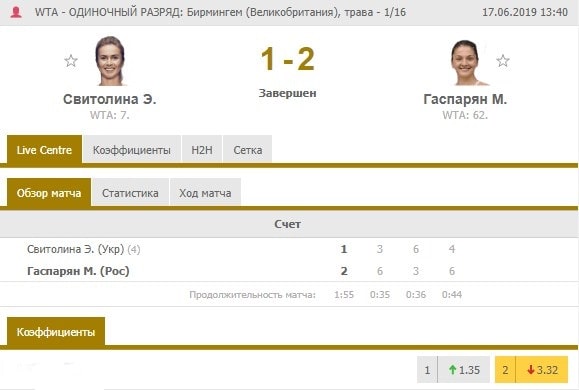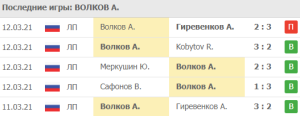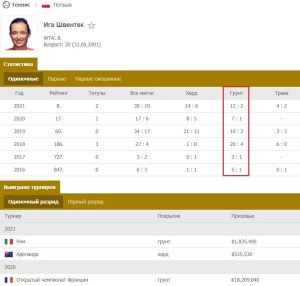
Every sport has stereotypes that make bettors make the same mistakes that lead to losing. Each time with such a loss, the user thinks that it was an accident that prevented him from winning, in a similar situation he bets again and loses again, once again explaining the reason for the failure by chance. There are several false stereotypes in tennis that are obvious at first glance, but all too often lead to failure. We will consider them in the framework of this review.
Content
- Reassessment of the world ranking
- Tennis Player Winning Tournament Bets
- Negative top handicap in the first round
- Title Defending Tennis Player Betting
- Home match betting
- Summing up
Reassessment of the world ranking

In Birmingham, the 7th racket lost to the 62nd. There are times when the 10th racket can lose the 110th. Sparring, when a tennis player from the TOP-200, lost, for example, to the 450th racket even more.
Here the 579th men's tennis racket outplayed the 157th. The reasons for this failure lie in two important points:
- a more rated player does not play on a favorite surface, which, on the contrary, is a favorite court for his opponent
- top tennis player is experiencing a gaming crisis, his less-rated opponent is experiencing a strong rise
For these reasons, the emphasis should be placed not on the rating, but on the current form and type of court, where the sparring takes place, taking into account the “tastes” of the opponents.
The importance of the court factor in tennis can be found in a separate review.
Tennis Player Winning Tournament Bets
As soon as a tennis player not from among the tops wins a tournament, in the next tournament, many begin to bet on it, actively loading a negative handicap. But not a top athlete, who has done his best in one tournament, reached the final in it or won it altogether, rarely plays powerfully in the next one. If such a tennis player performed powerfully in several competitions in a row, he would be at least in the TOP-20. The instability of his performance does not allow him to rise so high in the rankings.
A striking example is the performance of an athlete from Kazakhstan – Yulia Putenciva. She managed to win the tournament on clay in Nuremberg in Germany, the final was held on May 25. And two days later Putintseva took part in the 1/64 finals of the French Open, where she lost to a less rated opponent.
For this reason, it is better to bet against the tennis player who wins the tournament.
But only when three main conditions are met:
- The time difference between participation in two tournaments should not exceed 3-4 days, when the player has not yet had time to normally recover emotions and tune in to the fight;
- The rivals got a strong opponent in good shape;
- This tendency is well manifested in ITF-category tournaments, where low-rated players or from the TOP-200 who are in a severe gaming crisis play.
This does not mean that all the players who won the tournament immediately fail in the next round of another competition after 3-4 days, but in the 2-3 rounds failure follows quite often. For this reason, experienced bettors are waiting for the player who has got “on the pencil” in the next tournament in the first rounds to come across a worthy opponent and then place a bet against the winner of the previous competition.
In general, betting on potential outsiders in tennis is a pretty promising area. You can learn more about them in a special material.
Negative top handicap in the first round
Do not think that the top player from the very first round demonstrates the maximum form. Many strong players are outright knocked out in the 1st round, unable to “catch” their game and adjust to the peculiarities of the court. The top, who decided to perform as much as possible in the tournament, is gradually gaining momentum, not giving his best in the first rounds and gaining maximum condition for the quarterfinals or even the semifinals.
One more point should be taken into account here: before the start of the main draw, there are 2-3 rounds of qualification. A tennis player who has passed all qualifications is gaining maximum shape. And when in the first round he came across a top rival who had just started in the tournament and did not get any special conditions, the probability of a victory of a less rated player who passed the qualification is high.
French athlete, Nicolas Mayu, being the 193rd racket in the world, managed to qualify and in the first round of the main draw, 1/16 finals, he met the 36th racket.
The less-rated opponent won by giving the opportunity to place a promising bet at a high odds.
It is dangerous to bet on a large negative handicap of TOP-50 players in the first round, it is better to look for other options
Title Defending Tennis Player Betting
Having won one of the tournaments, the player must defend him in a year, if he does not do this: he does not take part or immediately flies out, these points will be written off from him for winning. Realizing this, many young bettors actively drive a large negative head start on a tennis player defending glasses, placing a strong emphasis on his motivation. But strong motivation is rarely the key to success; over the past year, a tennis player could have lost a lot in terms of the level of play, or he could come across an opponent whose game is going up sharply.
The tournament in Rome shows how often tennis players defend their points in the next season, but one more thing is also visible here: in Rome, no one defended their tournament three times. Sometimes this happens due to the fact that the athlete simply did not take part for various reasons, but often the rivals did not allow the emu to do this.
It is really difficult to do this, rarely any tennis player not from among the frank tops, like Nadal, Djokovic and Federer in men's tennis, who have been holding the first three lines for years, Sharapova and Serena Williams in their time in women's tennis, can play at the highest level for three years contract. Many athletes in women's and men's tennis can play at a high level for 1-2 years, after which there is a gradual decline, and after a while the rise follows again.
How to correctly catch a streak of victories in tennis and other sports, a whole bet within it, read in a separate review.
In such a situation, experienced bettors wait for the athlete to decline in the game and play against him when he tries to defend points in a previously won tournament.
Home match betting
For an athlete performing at home, the motivation to play is always incredible. But not always motivation helps him to win in front of numerous fans. You can place a bet on such a player if the following conditions are met:
- When he is in good shape;
- Plays on favorite surface;
- He is opposed by an approximately equal rival;
- The bookmaker did not underestimate the odds on it.
The analysts of the bookmakers clearly monitor the mood of bettors. When they see that, for example, a German athlete is in good shape, then at a tournament in Stuttgart they may underestimate the coefficient on him, in such a situation it makes no sense to bet on such a tennis player. But such distortions do not always happen.
Italian tennis player, Camila Giorgi, who was in the TOP-30 in 2018, managed to pass the first round of qualification at the tournament in Rome, but there she got a compatriot as a rival. In the next round of qualification, she got an American, approximately equal in level of play. And such a load was observed in that fight.
There was a powerful load on the Italian, who played in her native Rome, but the American won.
Anyone trying to develop a successful game theory for betting on athletes playing at home should only pay attention to those cases when he is in good shape and grossly underestimated. This does not mean that he will win every time, but at a distance he will definitely come out in plus due to biasedly overestimated coefficients.
Summing up
It's not just that tennis is called one of the most difficult sports for betting, the bettor, when playing in bookmakers, must observe incredible flexibility of thinking, where the current level of the athlete's play and court coverage come first, and only then motivation, the level of the tournament and a number of popular stereotypes …


